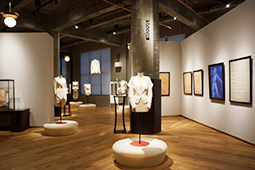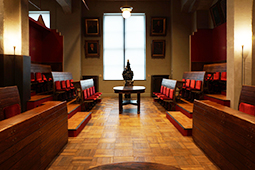 |
Focus features two in-depth reviews each month of fine art, architecture and design exhibitions and events at art museums, galleries and alternative spaces around Japan. The contributors are non-Japanese art critics living in Japan. |
|
|
 |
 |
 |
Layers Preserved: The Intermediatheque at JP Tower
Nicolai Kruger |
 |
|
| The refurbished façade of Tokyo Central Post Office now serves as the podium for the new JP Tower. Photo by Nicolai Kruger |
2013 is turning out to be a big year in Japan for the renewal of cultural monuments. The shrine complexes at Ise and Izumo will undergo their shikinen sengu, a total rebuilding that occurs every 20 and 60 years respectively. This tradition, which has been dutifully observed for over 1,000 years, is a painstaking labor of love and great expense. In Tokyo this spring, the Kabuki-za theater underwent its fifth renovation since opening its doors in 1889. Along with all of the modern upgrades, the theater's classical Japanese filigree now fronts a monolithic tower by Kengo Kuma.
In a similar old-meets-new approach, the Tokyo Central Post Office building (1931) has been heavily refurbished. Designed by architect Tetsuro Yoshida (1894-1956), it was hailed as a landmark of Japanese Showa-style modernism and was designated an important cultural asset by Docomomo in 2000. A large portion of the original five-story structure has been preserved along with its original stately façade, establishing the podium for Japan Post's glassy new headquarters building JP Tower (by Mitsubishi Jisho Sekkei Inc. in collaboration with Helmut Jahn). Keeping this cultural asset also maintains the datum set by the newly restored Tokyo Station in reinforcing the cultural significance of the Marunouchi district.
Exhibition view of the Intermediatheque foyer.
© Intermediatheque |
|
View of the Intermediatheque permanent exhibition on the second floor. © Intermediatheque |
The historic portion of this new complex now houses retail shops -- and on two floors, the new Intermediatheque, a museum jointly operated by Japan Post and the University Museum, the University of Tokyo (UMUT). As the name suggests, it is interdisciplinary, dedicated to art and the natural sciences. Its exhibits celebrate human inquiry and the pursuit of beauty. Visitors may be surprised to discover that their admission to Intermediatheque is entirely free. Because these cultural assets belong to Japan, they are meant to be enjoyed by all. Label text is provided in Japanese and English, making the experience indeed very accessible to all types of visitors.
Stepping into the museum's foyer one cannot miss the giant skeleton of a machikane wani (Toyotamaphimeia) prominently climbing up the wall. This ancestor of the alligator from the Pleistocene era was discovered near Osaka in 1964. Unfilled travertine on many of the surfaces provides a tactile backdrop. A grand stair ascends alongside the seven-meter-long wani, allowing visitors to see its enormous head in detail. Sensitive detailing continues as many of the display cases are originals repurposed but, like the space itself, not perfectly refinished. By restraining the natural tendency to make everything sparkly and new again, the museum maintains a rawness and authenticity felt throughout the spaces.
| Redesigned exhibition cases in the Intermediatheque permanent exhibition. © Intermediatheque |
|
View of the Intermediatheque special exhibition IMT in Construction. © Intermediatheque |
Upon entering Colonnades 2 and 3, the permanent exhibition spaces, one is reminded that this used to be the functioning Tokyo Central Post Office. The original parquet flooring remains, and the strong octagonal column grid and lofty open ceilings that used to envelop the mail sorting room now house relics, scientific specimens, and works of art accumulated by the University of Tokyo since its founding in 1877. Medicinal herb, plant, and fungi specimens, models of human anatomy, and an array of taxidermy birds, insects, lizards, and small mammals are interspersed among some great crowd-pleasers: a minke whale, a giraffe, and the enormous, now-extinct elephant bird (Aepyornis maximus). Thin steel frames around the skeletons provide an implied barrier while still allowing visitors to get up close. The Academia room is a replica of a lecture theater from the University of Tokyo Medical School as it would have appeared in the early 20th century.
Within Intermediatheque one encounters lovely discoveries around every corner, such as the artifacts on loan from the revered Museé du quai Branly in Paris. There are three rotating display spaces which will hold special exhibitions dedicated to "fruits of contemporary scientific research and artistic expression in harmony with the permanent exhibition." IMT in Construction, a mini-exhibit in the Grey Cube space, revisits the process of building the Tokyo Central Post Office. Large-scale photographs of the original construction are on display, as well as recent photos documenting the building's partial demolition and refurbishment.
 |
|
 |
View of the Intermediatheque special exhibition Anthropometria, on view until 27 October.
© Intermediatheque |
|
View of the Intermediatheque Academia.
© Intermediatheque
Unless otherwise stated, all photographs are courtesy of Intermediatheque. Design credit: Museography © UMUT works 2013 |
Whenever we ask, "What is worthy of preserving and to what degree?" a lengthy discussion ensues. Not everything that is old necessarily can or should be saved. Today we have a proliferation of records right at our fingertips: databases, digital images, and DNA sequencing of all types of animal and plant life, making it seem almost quaint to keep actual taxidermied animals, plants and fungi for posterity. But as with the important buildings of our past . . . once they're gone, they're gone forever. Being able to see these artifacts in the "flesh" fosters our curiosity and cultivates our creativity. The long stewardship of this collection is commendable and makes it well worth a visit.
|
|
|
 |
Intermediatheque |
 |
From 21 March 2013
(exhibition closing dates undetermined except Anthropometria until 27 October 2013)
|
|
|
 |
 |
Nicolai Kruger, AIA
Nicolai Kruger is an architect managing international projects at Pelli Clarke Pelli Architects, Japan. She has been living in Tokyo since 2006. She received her BFA in Design at Cornish College of the Arts in Seattle, followed by her Masters of Architecture at the University of Oregon. Her principal areas of interest include mixed-use, temporary structures, exhibition and lighting design. |
|
 |
|